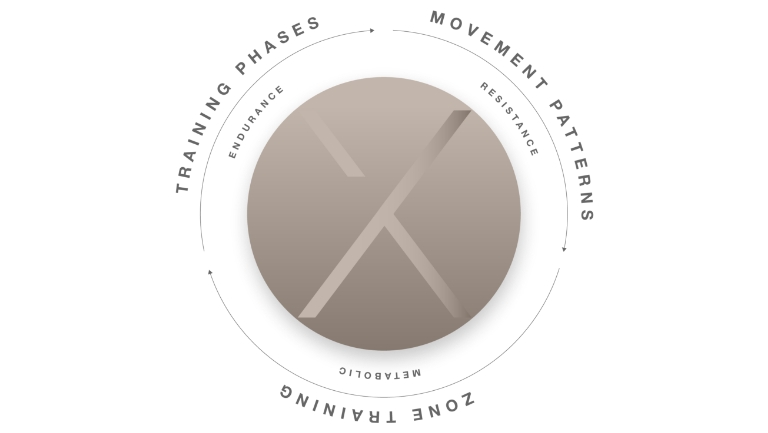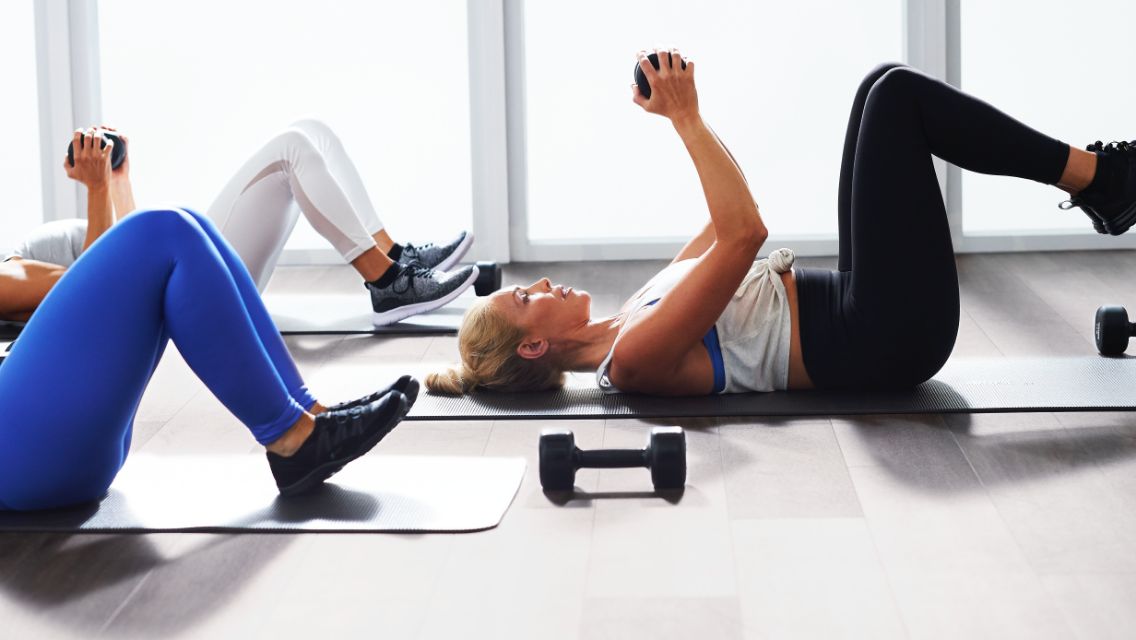Increased strength, greater muscle definition, improved metabolism, more energy, and whole-body transformation. These results are all possible with regular fitness efforts, yet the roadblock many of us run into is how: What exercises do we do? How often do we perform them? When do we switch it up or grow our efforts?
Those who want someone else to do the work of developing a plan for them — and use their expertise so there’s no guesswork — often turn to some type of training programming. For those who find benefit from the motivation, accountability, or camaraderie of working out alongside others, that’s often group training.
At Life Time, the group training program that’s designed to meet the needs of all people is GTX, which stands for Group Training Experience. And the results noted above? Those are just a few of the benefits participants stand to gain when they do this program.
So, what exactly is this results-driven program all about? We connected with Justin Barriball, CPT, one of our certified GTX trainers who is based out of Life Time in Tampa, Fla., to get all the details. Here’s what he had to say about the format.
LT Editorial | For those who have never heard of GTX before, can you give us a high-level overview of the GTX program?
Justin Barribell | GTX is one of three of Life Time’s Signature Group Training programs. GTX is our most widely used format, as it allows for the largest diversity in participation — you can come in as a day-one participant or an experienced athlete, or somewhere in between.
The class is a one-hour, circuit-style workout that involves an equal mix of cardiovascular and strength-training work and is based on heart-rate zones. Month-to-month, you cycle through three different training phases, each focused on a different aspect of your fitness (I’ll speak more to these later on).
The unique aspect of GTX is that it allows primary movements to be mastered during the program so that members can continue to progress in intensity.
You participate alongside other individuals — groups typically include 10 to 15 participants — and are guided by a highly trained GTX coach.
GTX was designed in a smart way to be scalable from a beginner to an avid exerciser. In other words, the program levels up as you level up. How cool is that? This doesn’t happen by coincidence — there’s a method to every decision we make with our programming.
GTX is not intended to be your average drop-in class; it requires consistent commitment to a longer-term program — ideal attendance is three days a week. This allows for safer and more measurable progress throughout the phases. The monitoring of improvement metrics makes it one of our most all-encompassing programs.
Participants can choose to remain in GTX — while continuing to advance — or after a period, move into one of our other two formats, Alpha or Ultra Fit. These other two programs tend to feature more complex movements and are geared toward different goals.
LTE | Tell us a little bit about the method behind the 50/50 cardio and strength programming — why is that done and what are the benefits?
Justin Barribell | Programming to a 50/50 cardio and strength format allows us to progress athletes in the most efficient way possible. Our goal is to help individuals become the best and healthiest versions of themselves.
These workouts appeal to the largest demographic of our members, while simultaneously ensuring we cover all physical bases in a training block. We achieve this through proper progressions and periodization week after week and month over month in our classes.
What’s the benefit of following this 50/50 split? A common misconception we hear from members is that cardio isn’t a worthwhile effort if their goal is to build strength. While it is possible to get stronger through resistance training alone, incorporating a cardio base at proper intensities helps increase fat burn while maintaining muscle. It also decreases recovery times, allowing for more work to get done per class.
LTE | In addition to the intentional 50/50 split, what’s the power behind the design of GTX programming?
Justin Barriball | There are three main components featured in every class that contribute to the results- and science-based design of the programming:
1. Training Phases: We program phases by the month. There are three different phases you’ll rotate through: the first is “build your base,” which is dedicated to endurance; the next is “progress and grow,” which is focused on resistance; and the third is “challenge and perform,” which is centered around metabolic efforts.
Each time you go through the three phases you’re building on the previous progress you’ve made. This strategy allows for a more well-rounded athlete and prevents plateaus, stress-related injuries, and, frankly, boredom.
2. Movement Patterns: Programming is written for a six-day-a-week split to cover all body parts and movements. We do two days of “hinge and press,” two days of “squat and pull,” and two days of “unilateral and core.” It is recommended that members attend class three days a week to do one hinge/press, one squat/pull, and one unilateral/core workout.
Too often, people gear toward what they’re good at and/or what they enjoy in a fitness setting — this can lead to muscular and body imbalances and increase the potential for injury. This phased approach allows for adequate volume on each muscle group and overall better results.
3. Zone Training: This component is arguably the most essential programming factor. Each day, there is a different heart-rate zone assigned with the workout. This is an intensity and pace to stick to that’s specific to each participant based on their heart rate and rough percentage of their heart-rate max.
Each heart-rate zone correlates to a different fat utilization percentage, which estimates how much fat someone will burn during the workout and how long they continue movement.
For example, our Zone 1 days include much longer intervals and significantly fewer taxing movements from a heart-rate standpoint. Our Zone 4 days are considerably higher intensity but provide much longer rest periods between intervals. A program that includes a balance of zone work is best as each zone offers benefits toward overall health and fitness.

LTE | What equipment can you expect to see used in a typical GTX workout?
Justin Barribell | GTX uses the treadmill for cardio efforts, and follows a free-weight format for strength work, using a combination of dumbbells, resistance bands, kettlebells, and medicine balls.
LTE | GTX is designed to have positive physiological and psychological effects. Can you explain what physical and mental shifts are happening during prolonged exercise?
Justin Baribell | Physiologically, our athletes can expect to see a total change in body composition, meaning they are likely see a decrease in body-fat percentage, an increase in overall strength and mobility, and the potential to complete higher-level movements over time.
The initial response to the onset of movement is the secretion of pituitary hormones, which result in a reduction in the plasma concentration of insulin and a rise in virtually all other hormones. Because of this shift in hormone balance, a modification of the metabolism of intra- and extra-muscular triglycerides and glycogen as fuels for muscular exercise occurs.
From a mental standpoint, this is a massive confidence booster. We also see improvements in overall mood and stress management from the natural hormone production that occurs during exercise.
Most importantly, in my opinion, members gain essential accountability factors from working out in a social environment like the group setting we facilitate. The relationships built within the community allow athletes to stay engaged in the class for a more extended period, thus enabling better results to come to fruition. Extra faces greet you, cheer you on, and hold you accountable to your commitments.
LTE | Although you’re exercising in a group setting, are coaches able to scale up or scale back the workouts for members, depending on the individual?
Justin Barribell | We allow for the scaling of movements through two methods: the design of our programming and the hands-on expertise of our coaches.
Our GTX programming panel (the people responsible for designing and optimizing the programming) places a huge emphasis on making sure the specific exercise selections we include offer a variety of progressions and regressions — meaning we can make them more complex or straightforward, depending on the needs of the member.
This approach allows a group setting to be catered to an individual instantaneously. Everyone can perform the same movement pattern, like a squat for example, but can be doing a variation that’s challenging but manageable to them specifically.
The only reason this approach to programming design is successful is because of the knowledge of our group training coaches. They are some of the most premier in the industry from an education and certification standpoint. They are extremely well-versed at taking the movements we program and providing proper variations depending on the needs and experience level of individuals in the class.
LTE Editorial | If someone is interested in GTX, how can they get started?
Justin Barriball | If you’re already a Life Time member, you need the Signature Membership type — with that, unlimited signature group training classes are complimentary to you (including GTX, Alpha, and Ultra Fit). If you’re not on a Signature Membership, you can try a week of unlimited group training to see if you like it by filling out this form.
Not currently a Life Time member? Learn more about the Signature Membership here.





